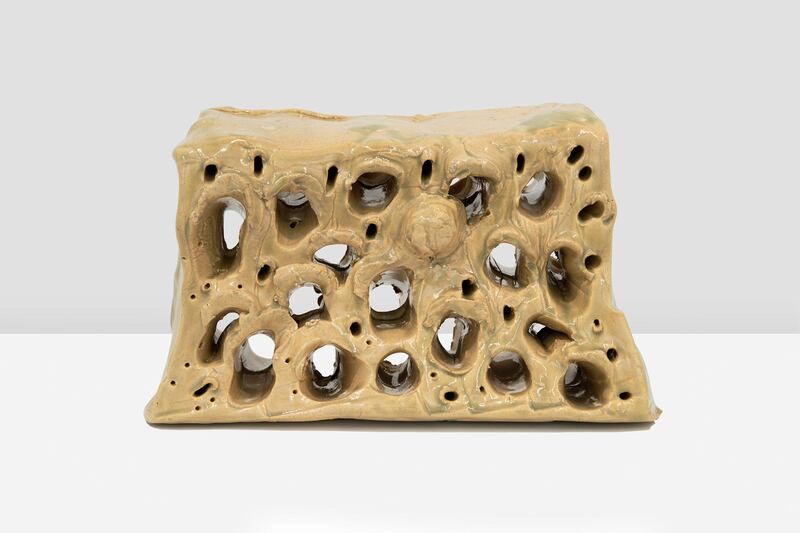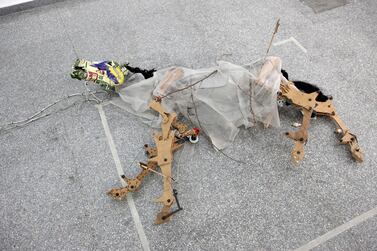The opening room to Works and Days, Simone Fattal's exhibition at Moma PS1 in New York, is filled with origin stories: Adam and Eve, prehistoric gods and even Fattal's own – the first ceramic sculpture she made in 1988. Titled Torso Found in Today's Downtown Beirut, it looks like an ancient bust, stone-coloured and craggy in places, as if weathered by time. Nearby, a small lion sits, its mane bearing the traces of the artist's hands, with eyes almost entirely gouged out. The room sets the tone for the retrospective of the Lebanese-American artist's work: this is a place where the ancient and contemporary meet.
Fattal was born in Syria in 1942 and educated at a boarding school in Lebanon. She studied philosophy at university in Beirut, and her work abounds in mythological references, from the Epic of Gilgamesh to the lesser-known Arab tale of Dhat Al Himma, as well as scenes from Homer's Odyssey and the Bible. The works bear their allusions lightly: their natural colours, number and small scale also suggest a connection to the time of their making.
"When you are working with ceramics, you are close to life, close to the earth," she says. "You are touching live earth and so you are touching a very primitive medium – the most primordial medium you could have. It is an extremely enriching and stimulating way of working."
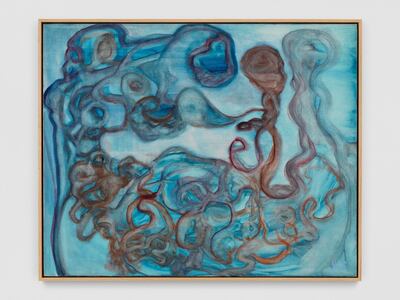
Fattal began making ceramics in 1988, having painted since the late 1960s, when she took up abstractions after her plans to establish an independent school for philosophy in Beirut fell through. She and painter and poet Etel Adnan stayed in Beirut at the beginning of the Civil War, leaving for San Francisco in 1980. There, she founded the Post-Apollo Press, which publishes poetry, experimental writing and translation, including the poems of Adnan.
After moving to Paris in the early 2000s, Fattal returned to her own artistic practice. Works and Days, the solo show at PS1, is comprised mostly of her ceramic work from this period onwards, in addition to some ceramics from the 1980s and ’90s, a few of her paintings that survived from the 1970s, and paintings, watercolours and collages that she started making again recently.
Ruba Katrib, the show's Syrian-American curator, whittled down the list of possible works for the exhibition from 400 to approximately 250. Rather than organising the retrospective chronologically, the PS1 curator built a scenography for the works. The first room is the "Origins" space, while the second room resembles a village, showing Fattal's maquette-size figures engaged in everyday activities.
"We titled the exhibition Works and Days, from Hesiod's poem in ancient Greece," Katrib says. "In Works and Days, Hesiod writes an almanac of how to grow crops, but also how to deal with your neighbour and how to deal with the gods. It's all in one together. That distinction between mythology and daily life is also really integrated in Simone's work."
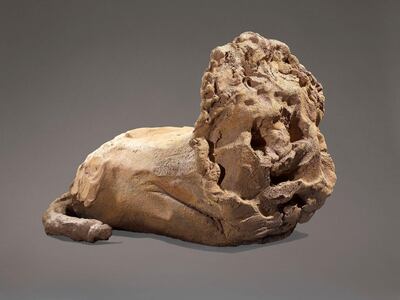
Myths, Katrib says, are as much tales of heroic battles as stories of love and devotion between their characters. She says that Fattal's predilection for repetition frames mythology in new ways: a mother-and-child dyad can as easily be a scene you pass on the street, as one from ancient mythology.
"When you're going through the spaces of the exhibition, you pass different architectural structures," she says. "The idea is to spend time with the works differently. Repetition is a big factor in Simone's work. She's communing with or summoning these entities, these figures. Two sculptures can seem quite similar, but their titles are extremely different. One could be a warrior and one could be a mother and child." This possibility for interpretation that is embedded in her work means it feels alive. In a series of four collages Fattal makes the link between the ancient past and recent American history in the region explicit. Collages from 2016, including They Have Found Weapons of Mass Destruction and Mourir à Amman, which shows photographs of the corpses of Saddam Hussein's sons Qusay and Oday after their autopsies, use images of ancient artefacts with contemporary images, pictures of animals and plant life, and historical images of the region's colonialist past.
In some ways, archaeology might seem like the obvious subject for an artist in the Middle East. Who wouldn't feel inspired by the remarkably stylish forms that have travelled down from the Akkadians and the Assyrians to the contemporary age? But it's also not a straightforward one. Both literally and theoretically, archaeology belongs to histories of western colonialism. Most of the artefacts that constitute the visible culture of the region's past were unearthed by English and German teams and are displayed in western museums. And from the 18th century onwards, western historians took on Mesopotamian, Greek and Roman culture as the West's pre-history, bundling it up into a linear concept of heritage.
In the Arab region, by contrast, the remains of the ancient past are more plentiful, and less sanctified. Architectural historian Nasser Rabbat, for example, argues that the Arab cognate for "heritage", or "turath", focuses on pre-Islamic oral culture and poetry, with no emphasis on material culture.
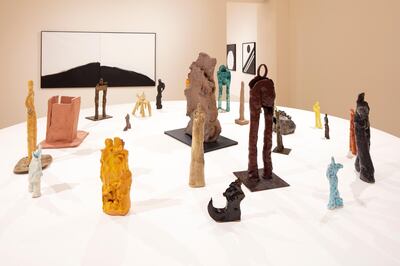
Nevertheless, archaeological remains are an important subject among Arab modernist artists, where their continuity with the present is often emphasised. Sudanese artist Ibrahim El Salahi toured his homeland to discover the traditional Sudanese iconography that was still in people's homes. Jordanian-Lebanese sculptor Mona Saudi, roughly a contemporary of Fattal's, said she was inspired by the ancient ruins she played among as a child for her polished, totemic sculptures.
Fattal's work continues this connection between past and present, but there is also a marked criticality to her ceramics, or even simply a restlessness that moves it away from the classicism that typifies much of Arab modern art, and which to a certain extent characterises her luminous, accomplished paintings.
The sculpture A House in Damascus, from 2010, is a roughly hewn figure perched on the roof of a ochre-coloured home, with an Arabic inscription scratched out above the arched doorway. In a series of figures, the human form is only vaguely signalled: a single slit in a thick base conjures two legs. A series of warriors comprise strong, trunk-like legs, with a simple archway where the torso and head would be. Wall I and Wall II show walls with myriad holes through them, as if punctured by large bullets. The political travails of the Arab region are another recurring theme in Fattal's work, from the Lebanese Civil War to the destruction of Palmyra, which Fattal looked at in her 2016 Sharjah Art Foundation show, to the Iraq War collages.
Placed among the latter is also an image of one of Fattal's works. She too, she seems to say, is part of the region's long history.
Simone Fattal's solo exhibition, Works and Days, is at Moma PS1 in New York until Monday, September 2
